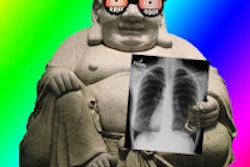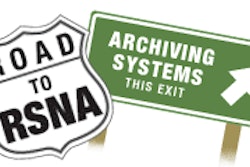
Of the thousand daily frustrations I experience as a radiologist, perhaps the most painful is that of the "portable patient." You see, patients migrate from hospital to hospital, from clinic to clinic, and from office to office. They may be searching for a second opinion, a superspecialist, someone who will give them the particular answer they seek (some want to hear good news, some prefer bad news), convenience, drugs, or some combination of the above.
As often as not, they acquire a mountain of imaging studies along the way. When asked why they had a particular study at a particular site, the answer is invariably, "My doctor told me to have it there."
Add to that the dependence on our ERs for emergent (or maybe just impatient care, as I like to call it), and the ER's love of imaging studies. Put them together and you've got a collection of the patient's imaging studies spread across a city or even a state.
Americans place a tremendous amount of trust in their physicians. I think it is well-deserved, for the most part. However, you are all aware of the huge number of imaging devices being placed in clinicians' offices.
With declining revenues, the docs had to turn somewhere to keep their incomes steady, and imaging is nothing short of a cash cow. Of course, every last one of these installations is placed solely for the benefit of the patients, or so I'm told. It's just so much more convenient for them to have their scan right there in the doctor's office, rather than trudge down the block to the cold, impersonal hospital where parking is scarce and the waiting room smells funny.
It should not be shocking to learn that utilization of imaging resources doubles, triples, or even quadruples if takes place in the physician's office. This is simple human nature. Mrs. Jones has a pain. To paraphrase Shakespeare, "To scan or not to scan -- that is the question," or the modern-day version: "To generate technical revenue or not to generate revenue -- that is the no-brainer." Well, OK, maybe the thought process isn't as blatant as that, and most likely every single scan on an individual basis is justified. Still, the statistics bear out that the coin in this case lands on "heads" significantly more often than "tails."
There is great debate among the radiological community about this sort of thing, but wherever your opinions may lie, two factors are evident: First, the insurance companies, our sometime friends (and most times enemies), are hemorrhaging money over this issue, and will likely be the ones to put a stop to anything smacking of self-referral. (There is, of course, that little thing known as the Stark Act that also helps "govern" this self-referral issue, though it contains loopholes the size of Montana.) Second, self-referral is with us for the time being, so add to the list of patient exams those performed in their physicians' offices.
Back to things technical. Mrs. Jones, our fictional patient, with abominable, I mean abdominal pain, has undergone six imaging studies at five difference locations within the last week, including two CTs within three days of each other, the second (of course) at her doctor's office scanner. This is quite a bit of imaging, not to mention radiation. I'll avoid the obvious controversy as to why Mrs. Jones had a repeat CT. Let's assume her pain worsened and her internist wanted to monitor her progress. To accomplish this, it's critical to have the old scan available to compare to the new. I deal with this scenario several times a day.
The ideal situation would, of course, have the patient undergo all her studies at one location, which somehow never happens. Sometimes the patient brings in old studies on a CD-ROM (which may or may not be DICOM-compatible) or even on icky old film. Some have studies on the many and varied PACS systems at other neighborhood hospitals, all of which should allow access to each other's images through DICOM query and retrieve, although few do in reality.
Of course, even if you can access the other hospital's PACS where the comparison study lives, you aren't out of the woods. There are seven different PACS systems my group may have to use to track down a comparison (and keep in mind that some fickle, I mean well-traveled patients might have studies on several of these).
For my group, it is the oncology clinic that is the nexus of this mess at the moment. Our viewing rooms there each have seven monitors and three computers, and they begin to look rather like the bridge of the Enterprise. Comparing CTs slice by slice between the study on the monitors in front of me and those behind me is a real pain, and this is certainly a setup for disaster. It would be a terrific advantage for me and particularly for Mrs. Jones, to be able to pull up the comparison within the PACS I am currently using to read today's study.
You see the problem. What to do? I suggest a rather bold solution: a citywide, a statewide, or even a national PACS system. I proposed this radical idea of a citywide PACS to the powers that be at our larger hospital, and was told, "You can't expect us to work with that other hospital that's suing us," referring to the acrimony generated by a competing hospital's challenge of a certificate of need.
Petty politics scuttled a potential savings of several million dollars, and compromised patient care. This sort of stuff has to be overcome somehow. All I can do is to point out the economy of scale, that a big PACS might be cheaper than two smaller PACS, and more important, that mobile patients need to have their imaging studies equally transportable. But the answer may not lie in a bigger, badder PACS setup.
I've been dealing on a small scale with the problem of networking widespread scanners and disparate PACS systems. I am not well-versed in DICOM, but my simplistic view of connectivity is that you have to establish some sort of secure TCP/IP connection, usually via a virtual private network (or VPN), and you must know the application entity (AE) titles, ports, and internet protocol (IP) addresses of the origin and destination systems. I find myself trying to remember IP addresses from a dozen sites, and if I'm off by one digit, we accidentally send Mrs. Jones' scan to the wrong place, like maybe Tanzania. There has to be a better way to connect!
Napster for PACS
The blog post from which this article has grown was prompted by an idea from my friend Mark (I know at least three Marks in the PACS business, by the way, but this Mark knows who he is) who suggested the intriguing idea of "Napster PACS": Let the network figure out who is where and what is what, like the old Napster peer-to-peer network. This is the better way.
Keep in mind, Napster PACS would have more security issues than Napster ever did due to patient confidentiality and HIPAA. But there's the solution to that: an automatically tunneling network on the order of LogMeIn.com. In their white paper, the LogMeIn.com approach is compared to a more standard VPN. Since the LogMeIn folks wrote it, they win the comparison, but look over their arguments and you will agree.
Basically, with proper ID and password authorization, you can tunnel into another computer. I've been using their system to maintain all the computers under my domain (about 20 or so), and it works like a charm for remote control, file transfer, maintenance, removal of spyware and viruses (don't let the kids and the spouse use the company computer, PLEASE!!) and the like.
Now I assume this Napster-like approach would require at least minor and possibly major revisions to the way we do things, possibly some surgery to DICOM itself. But in my simplistic world, wouldn't it be nice to "LogMeIn" at the remote site, scanner, etc., and have the receiving PACS system instantly recognize you as a friendly source of data?
The final piece of the puzzle requires matching patients. Is today's Mrs. Jones at the oncology clinic the same Mrs. Jones that was scanned at Saint Elsewhere last month? There are a number of ways to figure this out, but sooner or later we are going to have to have some sort of universal identifier for all of us. The Social Security number is probably the best bet for this, although we have to deal with the situation of multiple people using the same number, something that happens a lot, I'm told. Perhaps we could append the patient's initials and/or date of birth onto the SSN ("Social" as it's called here in the South) to individualize it further.
I think this idea has the potential to markedly simplify the way we connect, and to solve the problem of the portable patient. As it turns out, I am not the first to come up with peer-to-peer concept, or the possible approaches thereof. A real expert, Dr. Paul Nagy, tells me that this idea has already been discussed, and even implemented on a small scale.
It seems that Dr. David Channin proposed the term "PACSter" in an article in the Journal of Digital Imaging in 2001, outlining a peer-to-peer network for sharing of medical information, including images, of course. Even the government has been in favor of so-called regional health information organizations (RHIOs) and health information exchanges (HIEs). One company, Hx Technologies, has even put this concept into practice in Pennsylvania.
To avoid sounding terrifically naïve about all this, I, the Dalai Lama of PACS, consulted my counterpart, the PACS guru, Michael Cannavo, better known as the PACSman here on AuntMinnie.com. First, he noted that the whole concept lives or dies by HIPAA, and heaven knows he's right about that. We have all heard of (or experienced) situations in which HIPAA was invoked to keep us from information we needed. (In my case, a lab tech from one of the hospitals I serve refused to fax my son's lab results to me even though this had been done every week for the previous four months. HIPAA, you know.)
With all this in mind, I contacted Hx president Dr. Elliot Menschik, and even after he realized I was not the real Dalai Lama, but simply an interested radiologist, he was still happy to share his thoughts on all of this.
Instead of fighting the HIPAA police, Menschik has actually embraced HIPAA in Hx's iHistory product as a template for authorization and compliance. Menschik said, "... in effect, the (peer-to-peer) approach allows the network to enforce whatever policies a particular site has at their perimeter, just to do it much more efficiently than the typical paper-based approach." It is understood that the patients must give permission for their data to be available to Dr. X, and you can carry that forward electronically just as easily as on paper.
Yet another company is attacking this problem. Healthcare IT firm Empiric Systems recently announced that it plans to partner with Radster, designer of the Radster Client. Radster Client is a free software package that offers secure instant messaging, peer-to-peer file sharing, and DICOM viewing technologies to facilitate exchange of electronic medical information, digital images, and consultations between hospitals and other healthcare providers. I really like the "free" part.
Cannavo's second observation concerns the nuts and bolts of transmitting the data. DICOM standards supposedly, well, standardize image formats so Brand A's scanner can send images to Brand B's PACS. Sadly, DICOM is DICOM is DICOM, except when it isn't. In particular, Brand B's PACS might use a proprietary compression scheme which differs from Brand C's version. So, the best bet would probably to share the raw, uncompressed DICOM data, but this would certainly double or triple transmission time. Hx is using a Web server and an Internet Explorer viewer plug-in from a Little Company (LC) that has been bought out by a Very Large Company (VLC). That raises some problems: Will VLC will license the scheme to everyone at a reasonable fee, or do we just go with slow, uncompressed DICOM? We're talking about a lot of data here, folks. Mrs. Jones might not live long enough for her scans to be sent uncompressed over dial-up.
My personal wish would be something in between: I really want the priors to appear in the window of my current PACS environment, but quickly, if you please. Perhaps a standard compression scheme could be agreed upon for all participants. Something like standard wavelet or JPEG2000 (which I hear may soon be incorporated into the hardware of new computers) would suffice for this purpose.
Finally, and most important, Cannavo notes the issue of overall acceptance of the concept. There will considerable finger pointing if some machine won't talk to another. County General won't want their arch rival, Saint Elsewhere, to have any access to their patient data. The cardiologists may squawk about the radiologists being on the same network they occupy. But again, following the HIPAA template should limit or really override these concerns. If the patient says it's OK, then it's OK. Quit whining.
From my perspective, the two greatest problems will be cost and the usual big hospital inertia combined with IT fears of something this big. To solve these, I will invoke the bully pulpit so graciously offered to me by AuntMinnie. (Now, everyone be careful not to step in the bully when I'm done.)
Letting go
Here's the sermon: Let your priors go. We need this concept. Really. Seriously. As a physician who deals with this sort of thing every single working day, I can tell you it's critical. A lot of people out there agree with me on this, or they will when they read this piece.
To be honest, I have no idea how much this will cost, nor do I care all that much -- I'm a radiologist, not a CFO. That said, the benefits to our patients are beyond price, in my humble opinion. If the cost is shared by the insurers, hospitals, and clinics on the network, and to some degree passed on to the patient as part of the price of their study, it should be palatable. Dr. Menschik says the overall cost of his system can be rapidly recouped on the basis of film/media savings. While that's how many of us justified PACS in the first place, the actual filmlessness and expected savings typically never materialize ''in part due to the costs of distributing images outside of your home network."
Cost notwithstanding (I know, easier said than done), hospitals probably won't like this idea, and the usual practice is to sit on such a proposal until it dies of suffocation or boredom. IT departments in particular have a way of stifling innovation like this. That has always amazed me, because these are the very people who get to play with all the new, shiny computers with the dazzling blinking lights. Sadly, some of the contact I have had over the years with IT has resulted in responses such as, "We can't do that," "It won't work," and the ever-popular, "We'll schedule a meeting in six months to talk about whether or not we should discuss this any further."
I attribute some of this attitude to "Trained Hopelessness," a phenomenon described by John Goodman and Cindy Grimm in ICCM Weekly, which is the feeling that it doesn't do any good to complain or rock the boat, so why bother? Also, there is some degree of satisfaction with mediocrity overall. I am reminded of a quote about the Sirius Cybernetics Corporation from the Hitchhiker's Guide to the Galaxy by the late, great Douglas Adams:
It is easy to be blinded to the essential uselessness of (their machines) by the sense of achievement you get from getting them to work at all. In other words ... their fundamental design flaws are completely hidden by their superficial design flaws.
The technology to cure the malady of the portable patient exists today, and we need to start implementing it. The ideas I have proposed (reintroduced, recycled, borrowed, what have you) hand IT the chance to rule the world, or at least the region, if IT wishes to step up to the plate.
Personally, I think radiology and IT need co-dominion over PACS to ensure that the sort of progress we need will happen now, not five or 10 years from now. Boy, am I going to get some hate-e-mail on that.
But when Mrs. Jones bounces around to the next facility, she'll thank us for getting this all squared away. Unless someone wants to deny her the God-given right to migrate from hospital to hospital, that is.
By Dr. Sam Friedman
AuntMinnie.com contributing writer
November 16, 2005
In addition to regular posts in AuntMinnie.com's PACS Digital Community Discussion Groups, Dr. Friedman also maintains a blog at www.doctordalai.com.
Would you like the opportunity to meet the Dalai Lama and his counterpart, the PACSman (a.k.a. Michael Cannavo)? If you're going to this year's RSNA meeting, you can! Just come by AuntMinnie.com's booth 4901 on Monday, November 28, anytime between 1 and 3 p.m.
Related Reading
PACS preferences: How to push a radiologist's buttons, July 18, 2005
Copyright © 2005 AuntMinnie.com



















